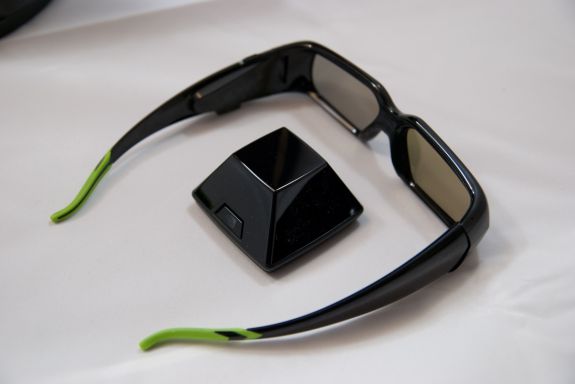ASUS VG236H 23-inch 3D Display Review: 120Hz is the Future
by Brian Klug on August 7, 2010 2:48 AM EST3D Vision on the VG236H
So let’s talk about 3D for a bit before going into the deep bits of the display’s performance. We’ve already covered NVIDIA’s 3D Vision here, but this review would just be incomplete without discussing how much I’ve changed my mind about 3D after playing with the VG236H.
First off, the NVIDIA 3D Vision kit itself is unchanged, though the packaging is a bit more compact. Inside is a soft cloth bag for the classes, two different nasal guides for comfort, two different length USB cables, the IR base station pyramid, shutter glasses, and demo and driver CDs. It feels like a high end product, with the base station pyramid and glasses sitting in foam cutouts, and the requisite accessories in a compartment above.
Additionally, you’ll need a 3D Vision compatible GPU, and can only drive 120Hz refresh rates over DVI-D, not HDMI. Because you’re rendering twice the frames (one for each eye), you’ll take a framerate hit for enabling 3D, so that GPU best be powerful. Zotac graciously supplied their ZOTAC GeForce GTX 470 for testing, which worked perfectly in my testbench.
I noted before that I’ve been skeptical about mainstream 3D gaming for some time now. I’ve seen my fair share of 3D content - though not as much as most of the other AnandTech writers that experienced it at CES on myriad displays - but have an above average grasp for the tech thanks to my optical sciences background.
That out of the way, most of the shutter or polarization based methods I’ve seen up until now suffered from being flickery. Refresh rate just wasn’t high enough, and the result was that I could detect individual frames when moving my head or really looking for it. In theaters, I tried the circularly polarized passive RealD system, and another IMAX 3D system using linear polarization. I had also tried a number of active LCD shutter systems on LCD TVs. While impressive, all of them had noticeable flicker.
The VG236H is the first 3D implementation I’ve played with that doesn’t have noticeable flicker. It just doesn’t. I was immediately impressed with the NVIDIA 3D Vision setup.
NVIDIA thankfully has a pretty comprehensive list of 3D Vision games and how good they perform with the whole system. At the top of the scale is 3D Vision Ready, meaning the game has basically been developed from the start to be viewed in 3D or 2D. Down the list is excellent, good, fair, poor, and not recommended. I first tried a number of ‘good’ titles, and found that while the 3D experience indeed worked, but often small things got in the way.













121 Comments
View All Comments
synaesthetic - Monday, August 9, 2010 - link
If your livelihood depends on color accuracy, you can damn well bet it's worth spending money on. Monitors cheaper than $300 have terrible color reproduction.Seikent - Saturday, August 7, 2010 - link
I have the Samsung 2233RZ monitor (120 hz, 3d ready, 16:10), it is a bit cheaper than this one, but it has some limitations.I don't have the shutter glasses, but I don't care too much because I don't have a Nvidia card. I bought it just because the 120 hz refresh rate. Playing with vsync on is awesome, the visual experience is much better, it feels fluid and it is hard to go back. It is hard to understand because you can't see it how it feels without having this monitor in front of you. I recommend you to try one.
JGabriel - Saturday, August 7, 2010 - link
Brian King: "I’d say the vertical angle you get isn’t quite as advertised, but honestly if you’re viewing the monitor from so far down below that this is noticeable, you’re probably doing something wrong ..."Or viewing it in portrait mode after attaching it to a pivot arm. Really, Brian, that should have occurred to you, as you bragged about "rolling your own" only a few paragraphs earlier.
.
JGabriel - Saturday, August 7, 2010 - link
Whoops, sorry for getting your last name wrong, Brian. I mis-read it somehow. Apologies..
Brian Klug - Saturday, August 7, 2010 - link
I agree, but the primary weird viewing angle is from below. From above, it seems much better (like many other TN panels, which is quite typical). I've encountered exactly that issue before putting a TN panel in portrait, and it definitely isn't desirable.I would definitely not recommend doing that with this ASUS ;)
-Brian
FH123 - Saturday, August 7, 2010 - link
Are 3D games, like Metro 2033, any better than what we get to see at the cinema? I saw Avatar (the film) and thought the 3D effects were laughable. In many scenes I could discern at most 3 or 4 planes of depth and, within those planes, everything looked flat. For example there might be a computer monitor in the foreground, then Sigourney Weaver, then the background. Where 3D worked it was mostly when things popped into the foreground, but the actors faces and backgrounds usually looked completely flat. South Park immediately sprang to mind. The actors looked like cardboard cut-outs in front of a background picture.Am I the only one noticing this effect? I admit my experience is very limited, as I walked out of Avatar half-way through and haven't watched anything 3D since. Nor do I have the desire to. The 3D effect was jarring and the film lost much of it's brightness, contrast and color saturation. What's the point? I own a good (JVC) projector. Something well recorded and not over-processed like, say, Treme (the TV series), looks far better to me than what I saw at the cinema that day. Depth perception, in that case, comes from low black-levels and proper dynamic range. Less dramatic, but it seems better to me.
Having said that, perhaps there is some advantage games have over films, even films that rely heavily on CGI, such as Avatar? Do they, perhaps by virtue of having a depth coordinate for every pixel on the screen, give a better continuity of depth perception?
Brian Klug - Saturday, August 7, 2010 - link
I agree with you, so that weird senstation is partly an artifact of 3D being added in after the fact, and partly just poor cinematography.The nice thing about games is that the 3D models are there already and have much finer meshes. I'd say that on the whole, no, that experience of things only existing in a few planes of depth is completely absent from gaming in 3D in any of the games I've tested thus far.
-Brian
nvmarino - Saturday, August 7, 2010 - link
Brian, great review, thanks!One of the benfits of a true 120Hz display (120Hz at the input) you didn't mention are the benefits for HTPC usage - a framerate that's evenly divisible by 60 and 24 means you can output both 24fps and 60fps content without having to change the refresh rate in the video card settings. Any chance you can confirm if the monitor supports HDCP on the DVI input? Also, any chance you could see if the commercial Blu-ray players (i.e. PowerDVD, TMT3, and WinDVD) play nice when outputting @120hz? Would also be good to know if Windows Media Center has any issues when outputting @120Hz as well!
Also, one minor gripe about your review - I think you're incorrectly referring to the system you're testing as "3D Vision Surround". "3D Vision *Surround*" is when using 3D Vision with multiple displays. Since you're reviewing with a single display it's just "3D Vision"...
Brian Klug - Saturday, August 7, 2010 - link
Excellent catch on 3D Vision Surround versus 3D Vision, fixed that!I'll test to make sure, but I'm 90% certain that it supports HDCP. It'd be absolutely unforgivable to be shipping a monitor in 2010 without HDCP. Having HDMI onboard pretty much guarantees that at least that input does, but I'll double check. I don't expect any problems though.
-Brian
Brian Klug - Saturday, August 7, 2010 - link
Just tested with PowerDVD 10 Mark II Version 10.0.1830.51 and playback is perfect - tried a variety of BD titles. Looks good at 120Hz (no stuttering). HDCP apparently does work over the DVI-D datapath.-Brian